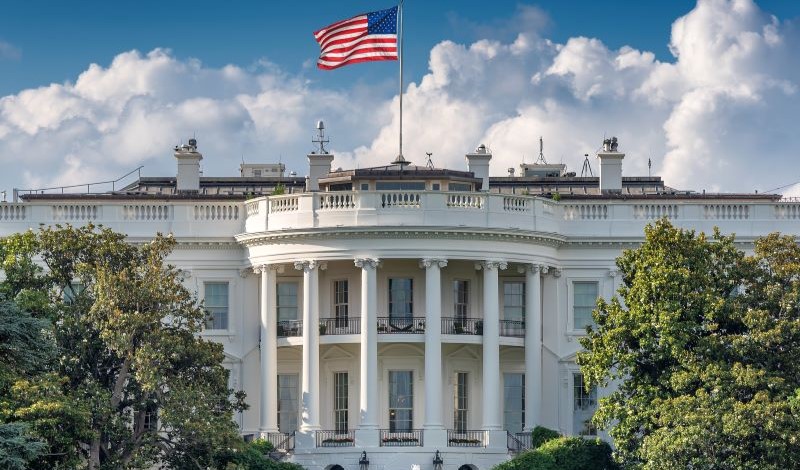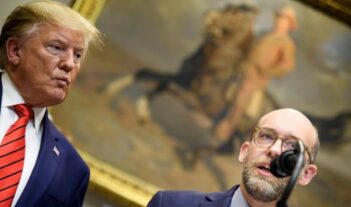
President Reagan introduced comprehensive White House oversight of agency regulatory activities.
With President Donald J. Trump’s election, regulatory reform is back in the headlines. John D. Graham’s book, Regulatory Reform From Nixon To Biden, provides an important and timely treatment of the topic. By taking a historical approach, Graham captures the ebb and flow of presidential efforts to shape—or stop—agency regulations before they are proposed, in order to bring regulation and deregulation in line with the President’s priorities.
The chapter on the Reagan Administration was of particular interest to me because in 1984 and 1985, I was President Ronald Reagan’s so-called “regulatory czar”—that is, the administrator of the Office of Information and Regulatory Affairs (OIRA) in the Office of Management and Budget (OMB), part of the Executive Office of the President. In that capacity, I conceived of Executive Order 12,498 which Graham describes modestly as “buttressing OIRA.”
White House control of the regulatory apparatus went from sporadic episodes during the Nixon Administration, to a more regular practice in the Carter Administration, to comprehensive oversight under the Reagan Administration. President Reagan’s Executive Order 12,291 formalized the process by requiring that all significant regulations be scrutinized by OIRA to ensure that they would, to the extent allowed by law, yield greater benefits than costs.
An early episode in which OIRA disapproved a proposed regulation was revealing. An agency head had appealed OIRA’s decision to the OMB director, then to the Vice President, and finally to President Reagan, to whom he said he would resign if the regulation was not issued. Agency staff were invested in the regulation, which had been in gestation for many years during which they had made commitments to congressional committees and external stakeholders. Rather than let the resignation ignite a firestorm of protest in the press and on Capitol Hill, the President acquiesced.
When I looked into the matter, I found that it was not at all unusual for a significant regulation to take a decade or more from conception to completion, as it goes from a literature review to a research grant, to a long-term study, to a proposal ready for public comment, and to adoption when OIRA signed off. No President could successfully impose policies on the regulatory state if the President’s only tool is to kill a regulation at the last possible moment.
Hence, I proposed—and President Reagan issued—Executive Order 12,498, which required that each agency head submit “an overview of the agency’s regulatory policies, goals, and objectives” for the upcoming year, with “information concerning all significant regulatory actions of the agency, planned or underway, including actions taken to consider whether to initiate rulemaking; requests for public comment; and the development of documents that may influence, anticipate, or could lead to the commencement of rulemaking proceedings at a later date.” Anything the agency wanted to do that could someday lead to a regulation had to be disclosed, or it was not authorized. The resulting inaugural Regulatory Program of the United States Government was published in 1985 and ran over 600 pages. The U.S. Department of Labor’s account of its “significant regulatory actions,” some of which were in the earliest stages of development, ran 100 pages. The account of such actions by the U.S. Environmental Protection Agency ran for almost 80 pages.
Graham describes the aim of Executive Order 12,498 as “enhancing OIRA’s power in dealing with agencies,” which is true in part. The greater goal, however, was not to empower OIRA but to enable—and require—the President’s political appointees to follow the President’s policies. As President Reagan informed the U.S. Congress in his message on the first Regulatory Program, “because some complex regulations take years to develop … it is important that senior Federal officials be able to review regulatory options early in the rulemaking process and plan regulatory actions over a longer time horizon.”
By requiring each agency to submit a regulatory plan to OIRA each year, Executive Order 12,498 was an action-forcing device. Henceforth, the heads of all agencies would be informed about all the pre-regulatory activity occurring in the agencies and could be held accountable by the President. As then Secretary of Commerce Macolm Baldrige told me after the first regulatory planning process, he was able to kill several regulatory projects that he would not otherwise have known about. Or as Cass Sunstein and Peter Strauss observed, Executive Order 12,498 provided “a means of ensuring that regulatory policy is set by agency heads rather than staffs.”
Because Presidents need regulatory planning to impose the President’s will on the administrative state, my predecessor at OIRA and I predicted in 1986 “that no future President will disestablish the process of regulatory review and regulatory planning.” That prediction has been only partially borne out.
The regulatory review and annual regulatory planning processes that President Reagan instituted continued through the Administration of President George H.W. Bush. But President Bill Clinton revoked both Reagan orders in Executive Order 12,866. As President Clinton explained, one of the purposes of his order was “to reaffirm the primacy of Federal agencies in the regulatory decision-making process.” To that end, he limited presidential oversight by providing that “OIRA may review only actions identified by the agency or by OIRA as significant regulatory actions.” The term “significant regulatory action” was given a four-part definition that included an action which likely would result in a rule that could “have an annual effect on the economy of $100 million or more or adversely affect in a material way the economy, a sector of the economy, productivity, competition, jobs, the environment, public health or safety, or State, local, or tribal governments or communities.”
The order also provided that cost-benefit analyses would henceforth be diluted by including “qualitative measures” and instructed agencies to consider “distributive impacts” and “equity.” It further excused agencies from including in their annual regulatory plan all but “the most important significant regulatory actions.” Although the order also required that, in addition to its regulatory plan, each agency “prepare an agenda of all regulations under development or review” accompanied by “a brief summary of the action”—now called the Unified Agenda of Regulatory and Deregulatory Actions—it left undefined the meaning of “under development,” so only the regulatory plan had to “be approved personally by the agency head.”
These changes undermined the system put in place by the Reagan Administration. Indeed, as Richard H. Pildes and Sunstein put it, Executive Order 12,866 “is significant mostly for the constraints it imposes on presidential oversight.” Those constraints persisted for the better part of the last two decades. President Barack Obama’s Executive Order 13,563 expressly reaffirmed President Clinton’s order. Then President Joseph R. Biden’s Executive Order 14,094 further diminished the utility of the annual plan by changing the definition of “significant regulatory action” from having an annual burden on the economy of $100 million to $200 million. The result was less disclosure to OIRA and to the public concerning agency initiatives, particularly at their earliest stages of development.
President Trump took immediate steps to address the deficiencies of the Clinton framework at the start of his second term. On the day he was sworn into office, President Trump issued Executive Order 14,148 in which he rescinded President Biden’s order that had weakened the definition of “significant regulatory action.” Eleven days later, on January 31, 2025, President Trump issued Executive Order 14,192, in which he required that “any new incremental costs associated with new regulations” be “offset by the elimination of existing costs associated with at least 10 prior regulations.” As part of that order, President Trump directed that “no regulation shall be issued by an agency if it was not included in the most recent version or update of the published Unified Regulatory Agenda” or approved by OMB. He further required that “no regulation shall be added to or removed from the Unified Regulatory Agenda” without the approval of OMB.
Less than a month later, on February 18, 2025, President Trump asserted authority over the independent agencies in Executive Order 14,215 and subjected them to the requirements of Executive Order 12,866. As explained in an accompanying fact sheet, “all agencies” going forward are required to “(1) submit draft regulations for White House review—with no carve-out for so-called independent agencies, except for the monetary policy functions of the Federal Reserve; and (2) consult with the White House on their priorities and strategic plans, and the White House will set their performance standards.” The very next day President Trump issued Executive Order 14,219, a significant deregulatory order regarding his Department of Government Efficiency (DOGE). He declared his policy “to commence the deconstruction of the overbearing and burdensome administrative state” and ordered the agencies to perform a sweeping review of “all regulations,” prioritizing rules “that satisfy the definition of ‘significant regulatory action’ in Executive Order 12866.” Going forward, new regulations must continue to comply with the process set forth in Executive Order 12,866 and, in addition, “agency heads” are required to “consult with their DOGE Team Leads and the Administrator of OIRA on potential new regulations as soon as practicable.” Substantively, agency heads, DOGE, and OIRA must consider the factors set out in Executive Order 12,866 as well as the additional factors in Trump’s deregulatory order.
Most recently, on April 9, 2025, President Trump issued an executive order aimed at reducing anticompetitive regulations. The order requires agencies, in consultation with the U.S. Federal Trade Commission and U.S. Department of Justice, to review all regulations—prioritizing “rules that satisfy the definition of ‘significant regulatory action’” in Executive Order 12,866—and identify rules that reduce competition. Then the agencies must provide OMB a list of regulations that warrant rescission or modification and work with OIRA “to decide whether to incorporate the proposed rescissions or modifications into the Unified Regulatory Agenda.”
All said, Trump’s deregulatory juggernaut has placed OIRA squarely in the driver’s seat and given it a sweeping mandate over agency regulations past and future. The questions now are the extent to which his deregulatory initiatives succeed in court, and whether his degree of control persists in future administrations. With respect to the former, Graham explains in his book that Trump’s deregulatory actions in his first term fared poorly in court compared to those of his predecessors, often due to unforced errors. We should expect improved performance from the second Trump Administration. I also expect Trump will eventually eschew Clinton’s Executive Order 12,866 altogether in favor of a new, comprehensive executive order setting forth the process by which the president can control the administrative agencies going forward.




